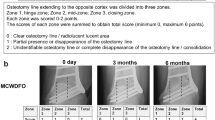Abstract
Purpose
Biplanar distal femoral osteotomy (DFO) is thought to promote rapid bone healing due to the increased cancellous bone surface compared to other DFO techniques. However, precise data on the bone surface area and wedge volume resulting from both open- and closed-wedge DFO techniques remain unknown. We hypothesized that biplanar rather than uniplanar DFO better reflects the ideal geometrical requirements for bone healing, representing a large cancellous bone surface combined with a small wedge volume.
Methods
Femoral saw bones were assigned to 4 different groups of varization distal femur osteotomies: group 1, lateral open-wedge uniplanar DFO; group 2, medial closed-wedge uniplanar DFO; group 3, lateral open-wedge biplanar DFO; and group 4, medial closed-wedge biplanar DFO. Bone surface areas of all osteotomy planes were quantified. Wedge volumes were determined using a prism-based algorithm, applying standardized wedge heights of 5, 10 and 15 mm.
Results
The biplanar osteotomy techniques (groups 3 and 4) created significantly larger femoral surface compared to the uniplanar groups (groups 1 and 2) (p = 0.036). Bone surfaces after the lateral biplanar open-wedge technique (group 3) were slightly larger than the medial biplanar closed-wedge technique (group 4) and biplane techniques significantly larger than the uniplanar techniques (groups 1 and 2). Wedge volumes were significantly higher in the lateral uniplanar open-wedge (group 1) and biplanar open-wedge (group 3) techniques compared to the closed-wedge techniques (groups 2 and 4) that have nearly absent wedge volumes.
Conclusion
Bone geometry following DFO suggests that the medial biplanar closed-wedge technique simultaneously creates smaller wedge volume and larger bone surface areas compared to the lateral biplanar open-wedge and the uniplanar DFO techniques. The horizontal cuts of the biplane DFO techniques are positioned behind the trochlear area in better healing metaphysial bone, which further enhances bone healing potential. Although this idealized geometric view on bony geometry excludes all biological factors that influence bone healing, the current data confirm the general rule for osteotomy techniques: reducing the amount of slow gap healing and wedge volumes and simultaneously increasing the area of faster contact healing by larger bone surface areas may be beneficial for osteotomy healing.




Similar content being viewed by others
References
Brinkman J-M, Hurschler C, Agneskirchner JD, Freiling D, van Heerwaarden RJ (2011) Axial and torsional stability of supracondylar femur osteotomies: a biomechanical investigation of five different plate and osteotomy configurations. Knee Surg Sports Traumatol Arthrosc 19:579–587
Brinkman J-M, Hurschler C, Agneskirchner JD, Freiling D, van Heerwaarden RJ (2011) Axial and torsional stability of an improved single plane and a new biplanar osteotomy technique for supracondylar femur osteotomies. Knee Surg Sports Traumatol Arthrosc 19:1090–1098
Brinkman J-M, Hurschler C, Agneskirchner J, Lobenhoffer P, Castelein RM, van Heerwaarden RJ (2012) Biomechanical testing of distal femur osteotomy plate fixation techniques: the role of simulated physiological loading. Submitted/Accepted for publication Injury
Farouk O, Krettek C, Miclau T, Schandelmaier P, Tscherne H (1998) Effects of percutaneous and conventional plating techniques on the blood supply to the femur. Arch Orthop Trauma Surg 117(8):438–441
Freiling D, Lobenhoffer P, Staubli A, van Heerwaarden RJ (2008) Medial closed-wedge varus osteotomy of the distal femur. Arthroskopie 21:6–14
Freiling D, van Heerwaarden R, Staubli A, Lobenhoffer P (2010) The medial closed wedge osteotomy of the distal femur for the treatment of unicompartmental lateral osteoarthritis of the knee. Oper Orthop Traumatol 22(3):317–334
Jacobi M, Wahl P, Bouaicha S, Jakob RP, Gautier E (2011) Distal femoral varus osteotomy: problems associated with the lateral open-wedge technique. Arch Orthop Trauma Surg 131:725–728
Lobenhoffer P, Freiling D (2008) Development of plate fixators: current status and perspectives. In: Lobenhoffer P, van Heerwaarden RJ, Staubli AE, Jakob RP (eds) Osteotomies around the knee. Thieme. AO Foundation Publishing, Stuttgart, pp 263–270
Pape D, Dueck K, Haag M, Lorbach O, Seil R, Madry H (2012) Wedge volume and osteotomy surface depend on surgical technique for high tibial osteotomy. Knee Surg Sports Traumatol. doi:10.1007/s00167-012-1913-x
Perren SM (2008) Fracture healing. The evolution of our understanding. Acta Chir Orthop Traumatol Cech 75:241–246
Puddu G, Cipolla M, Cerullo G, Franco V, Gianni E (2007) Osteotomies: the surgical treatment of the valgus knee. Sports Med Arthrosc 15:15–22
Schenk RK, Willenegger HR (1977) Histology of primary bone healing: modifications and limits of recovery of gaps in relation to the extent of the defect. Unfallheilkunde 80:155–160
Staubli AE (2008) Radiological examination of bone healing after open-wedge tibial osteotomy. In: Lobenhoffer P, van Heerwaarden RJ, Staubli AE, Jakob RP (eds) Osteotomies around the knee. Thieme. AO Foundation Publishing, Stuttgart, pp 131–146
Staubli AE, Jacob HA (2010) Evolution of open-wedge high-tibial osteotomy: experience with a special angular stable device for internal fixation without interposition material. Int Orthop 34:167–172
van Heerwaarden RJ, Wymenga AB, Freiling D, Lobenhoffer P (2007) Distal medial closed wedge varus femur osteotomy stabilized with the Tomofix plate fixator. Oper Tech Orthop 17:12–21
Van Heerwaarden RJ, Wymenga AB, Freiling D, Staubli AE (2008) Supracondylar varization osteotomy of the femur with plate fixation. In: Lobenhoffer P, van Heerwaarden RJ, Staubli AE, Jakob RP (eds) Osteotomies around the knee. Thieme. AO Foundation Publishing, Stuttgart, pp 147–166
Visser J, Brinkman J-M, Bleys RLAW, Castelein RM, van Heerwaarden RJ (2012) The safety and feasibility of a less invasive distal femur closing wedge osteotomy technique: a cadaveric dissection study of the medial aspect of the distal femur. Knee Surg Sports Traumatol Arthrosc. doi:10.1007/s00167-012-2133-0
Acknowledgments
We thank Lars Goebel for helpful discussions and Hans Radenborg for assistance with the sawbones preparation. Henning Madry, Dietrich Pape and Romain Seil are partners in the project ‘Experimentelle und klinische Orthopädie der Großregion/Orthopédie Expérimentale et Clinique de la Grande Région’ from the Universität der Großregion/Université de la Grande Région (UGR), supported by the INTERREG IV Programme of the European Union.
Author information
Authors and Affiliations
Corresponding author
Rights and permissions
About this article
Cite this article
van Heerwaarden, R., Najfeld, M., Brinkman, M. et al. Wedge volume and osteotomy surface depend on surgical technique for distal femoral osteotomy. Knee Surg Sports Traumatol Arthrosc 21, 206–212 (2013). https://doi.org/10.1007/s00167-012-2127-y
Received:
Accepted:
Published:
Issue Date:
DOI: https://doi.org/10.1007/s00167-012-2127-y




